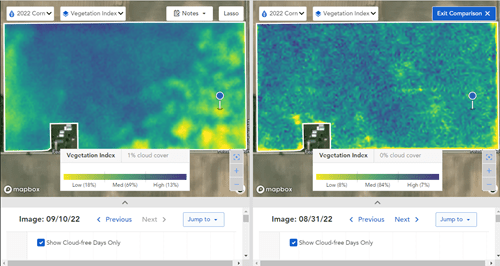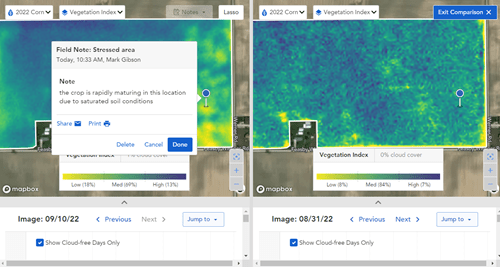Continue to Scout, Take Notes, Learn, Make Adjustments and Decisions For 2022
BY Dairyland Seed Agronomy Team
As we draw closer to corn and soybean harvest, make a habit of taking a note pad (electronic versions work, just be careful to not get wet) to your fields and plots to take notes of what you see. A few things to be mindful of when walking fields prior to harvest:
- Weed Escapes: Did your weed control plan live up to your expectations or do you have weeds that it missed? If so, do you recognize and know what weed it is? Or was it a timing issue when it was sprayed or worked, plugged nozzle or improper mixing? If you do not recognize or know what the weed is, contact your Dairyland District Sales Manager or Agronomist to help. We have seen an increase of Palmer Amaranth spreading into new areas, and we want to make sure we stop it where we can. Do you need more herbicide resistant traits like Dairyland Enlist E3® soybeans that allow you more flexibility in timing when you want to safely spray you crop as well as the products you can safely use?
- Disease Pressure: In corn, are you seeing heavier disease pressure this year versus previous years? Are you seeing new or different diseases starting to appear? We have seen near areas with Tar Spot and Physoderma Brown Spot and Stalk Rot, as well as Goss’s Wilt. In soybeans, look for Sudden Death Syndrome (SDS), Sclerotinia White Mold (SWM) Frogeye Leaf Spot (FLS). Have you seen them before? Are they in a new area? Do you need a different Dairyland Seed variety to help with these diseases or additional seed treatments or fungicide applications to help with control measures?
- Fertility: Are you seeing nutrient deficiencies in your crop? Did your nutrient management plan work or do you need to make changes? Do you need to split apply your Nitrogen and Sulfur in your corn or are your soybean leaves showing a yellow tint on the outside leaf margins which is showing Potassium (K) deficiency? Much like corn and alfalfa, soybeans do need fertility. Are you applying enough fertility to supply their needs?
- Insects: Are you seeing late season Corn Rootworm Beetles? Are they Northern, Western or Southern? This could have a bearing on what trait you use for next year’s crop. Are you seeing more areas with Soybean Cyst Nematodes (SCN)? Should we soil test those areas to find out SCN levels? Higher levels may warrant a different seed treatment or rotation.
- Standability or lodging: Did we have wind or weather events that will push up harvest on a field(s)? Consider which fields need to be harvested first and why.
In the last few years, utilizing a digital tool such as Granular Insights from Corteva has been a great place to store data from these late fall visits. Granular Insights allows you to place notes where threats are in the field allowing you to store that data for making seed and agronomic decisions later.
When you are walking Dairyland Seed plots, are you seeing products with better disease or insect tolerance? Do these products have better ear development or pod set? Do you like what you see? Take notes of what you like and don’t like about the products you plant, as well as the new products you see in the plot. These notes can help your Dairyland Seed Dealer as well as District Sales Manager and Agronomist fit the products you are looking for.
When the combine or choppers start to roll, take your notes with you and write down or type in what didn’t work or what you would like to change as well as the success you see. Did that new tile you put in help with water management? Did that additional nutrient application bring in more yield and/or a better quality crop. Taking good notes allows you to look back to decisions you made as well as forward to find what works and what needs to change.
Granular Insights
The directed scouting portion of Granular Insights can be a great tool for scouting during the growing season as well as before and during harvest. The Field Health Summary is a report built from percent change in the vegetation index, and gives recommendations for scouting priority based on percent change of vegetation index. The images shown above are maps produced from the directed scouting tool, the transition in color shows the percent change in the vegetation index or amount of biomass, with blue/green colors being “good” or little change areas and yellow indicating areas of great change where scouting needs to take place. The images are able to be viewed side by side in the Granular Insights application to compare the changes over time.

The picture below shows an example of the note feature. When scouting the note feature can be used to post a note directly to the map of a field. Notes are visible to anyone who has access to the field information. Two other note features Threat ID and Yield Estimating tool. The Threat ID allows you to take a picture of a suspect plant in a field and the tool Threat ID tool will identify any visible disease or deficiency from the picture. The Yield Estimate tool does what its name implies and estimates corn yields by counting kernels on an ear of corn from a picture and when harvest population and kernel size are entered an estimate is given. The notes created from all of these features can then be added to a field in the area where the notes were taken and appear as pins on the map.

Dairyland Seed’s Agronomy Team is more than willing to help you come up with solutions to make you more successful.
 |
 |
 |
 |
 |
| Brian Weller Western Region 507.456.3034 |
Dan Ritter Central Region 219.863.0583 |
Branden Furseth Northern Region 608.513.4265 |
Mark Gibson Eastern Region 260.330.8968 |
Amanda Goffnett Eastern Region 989.400.3793 |
